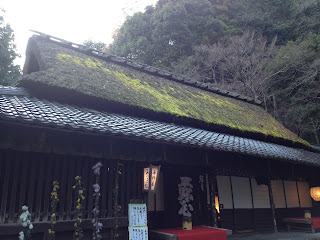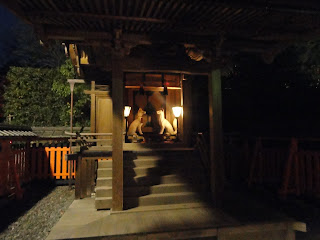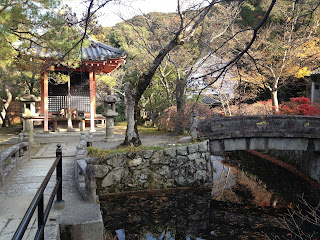H here. Day two of our Kyoto trip started out with such promise (how is that for obvious foreshadowing...). We had plans for a full day of sightseeing and unlike the previous day, we were going to have to get outside of Kyoto proper in order to see everything. We got an early start and headed first to the Nijo Castle (Nijo-jo) in the center of the city. What an awesome place. It was built in 1603 as a residence of the great Tokugawa Ieyasu, a
shogun (warlord) par excellence. Coming to power after one of the most famous military confrontations in Japanese history, the Battle of Sekigahara (where it is rumored Miyamoto Musashi, our boy's namesake fought), he founded the Tokugawa shogunate (dynasty).
This dude's digs.
We were unfortunately unable to take photos inside the castle itself, so we cannot share with you the opulent wall paintings, mainly in gold, of animals and plant life. What we can tell you however is that this was one paranoid warlord. Not only did the moat and outer castle walls seem impenetrable, but the castle itself was guarded against
ninja intruders (really, the real kind!) by the clever feature of what are called nightingale floors. Somehow, they managed to construct the wooden floorboards with springs embedded beneath them. To this day, whenever someone walks over them, they chirp and squeak, just like birds. Before I caught on to what it was, I wondered where the birds were and how many of them there must be to make the sound so deafening. I am not exaggerating, as the halls filled up with ambulatory visitors, the sound became so loud we had to raise our voices to hear each other, even though we were side by side. And of course I was making it worse by rocking back and forth and jumping up and down like a six-year old on a playground so that my own personal nightingales would chirp all the louder.
The grounds of Nijo Castle were glorious. They are not known to be the most beautiful gardens in Kyoto, but perhaps because we had missed the fall foliage season and all the hardwood trees were bare for the winter, the other gardens didn't hold a candle to this evergreen-dominated park.
Moat and castle walls.
The main castle complex with the nightingale floors.
Exterior woodwork detail.
Gardens.
I am so glad we didn't bomb it.
After the castle we walked over to the Kyoto Imperial Palace, set in an elongated park in the middle of the city (think Central Park in NYC). It was ok. It had started to rain and all the buildings and palaces themselves were closed to all except those who had made reservations to visit. We had not as we are not particularly palace people. The grounds were nice, dotted with groves of fruit trees and small shrines and there was a big fireplace in the cafeteria, but since we had other things to see that day, we didn't linger.
After the disappointment the day before of the Silver Pavilion that wasn't, I had decided that I wanted to make the trek to the far north western edges of the Kyoto area to the Golden Pavilion that was in fact golden, Kinkaku-ji. After a longish bus ride we arrived at yet another park and garden surrounding a pavilion that was indeed golden in its splendor.
It was lovely and I was satisfied.
Pine tree in training at Kinkaku-ji.
We had another long bus ride to our next destination and so we decided to eat lunch at one of the numerous restaurants that lined the streets leading to the pavilion. And that is when it happened.
Let me pause for a second, leaving you no doubt hanging in suspense, to tell you something about myself that if you have been reading this blog for any length of time you will no doubt already realize. I love food. I don't love food for the normal reasons of nourishment and sustenance. It is not simply fuel to me like it is to my brother, pity for him. For me, food is a part of my culture, my identity, my personality. I cook not because I have to, or because I can, but because it is who I am to create and share with others. My maternal grandfather, great-grandfather and great-uncle were cooks. I have inherited their gifts. My earliest memories were of food, mostly at Grandpa Sakamoto's house. He was a complex man, a US Army veteran of two wars. He expressed his affection for the people he loved not in the traditional way, but by feeding them.
Me being fed by my Grandpa Sakamoto.
From a very early age, he created in me a sense of food as love and connection, the mechanism for transmitting culture, identity and family values, the core of one's personality. This is illustrated by the fact that a large number of photos of me as a child center around food.
The all important lesson of how to eat rice with chopsticks.
Eating barbeque with my cousin.
And so I grew up food centric, way before it was trendy to be a "foodie."
I take this sense of the gastronomical on the road with me when we travel. As such, much domestic US travel depresses me because the food options in between point A and B are without fail mass-produced combinations of chemicals, preservatives and flavor enhancers loaded with fats, sugars and sodium. It is places like Asia where I can truly enjoy traveling to eat. So when we passed a moderately priced buffet that specialized in the local foods of Kyoto, I was sold.
It really was a lovely spread, centered around fresh vegetables. My favorite was a simple, custard-like tofu dish dressed with a clear sauce.
I had about four bowls of this tofu, including one for dessert.
In other words I ate too much. I ate till I was stuffed and then some. And somewhere along the way, I ate a tiny bug that made me very, very sick.
Here is me in the act of getting food poisoning. I am leaning over because T wanted to take the picture of the two ladies (mother and daughter) in traditional kimonos. At least I got to enjoy the meal while it happened. Later, I wouldn't be saying too many nice things about it.
To continue. We ate and ate and then rode the bus to the far western extremity of the Kyoto area, to a place along the Hozu-gawa river called Arishiyama. The main attraction there was a bamboo grove that is supposed to be otherworldly. I suppose it might have been if we had been the only people there. We weren't. But it was still very lovely.



Overlooking the Hozu-gawa River. T wants me to mention an interesting incident that occurred while we were at the overlook. After nearly two days of grumbling in frustration about not being able to understand a single word people of my own origin were saying and having to pantomime all requests, I was finally able to understand a conversation. Only it wasn't meant for my ears. Also present at the overlook was a group of Chinese tourists, a young couple with an older couple. The young woman wanted a group photo and suggested they ask us to take it. The young man said something to the effect of, you mean you are going to ask those foreigners to take our photo? Ah, how I love stealth eavesdropping. I turned around and said in Chinese with a big smile on my face, "I'd love to take your photo, but aren't we all foreigners in this country?" The young man was mortified, rest of his group was delighted. Later to make things up to us, he offered to take our photo. We obliged - the photo turned out junk.
We took a long walk into the countryside, weaving past numerous temples, quaint homes, lovely gardens, and small roadside shrines.
Again, those bibs...
The hut of a famous haiku poet and hermit, Mukai Kyorai. How is that for an awesome thatched roof?
Another thatched roof in Arishiyama.
As the winter afternoon deepened, we noticed the crowds growing particularly thick. Soon we were hardly walking at all, just being moved around by the mass of people. That evening, it turned out, was the start of a huge winter festival, marked by a light show in the bamboo grove and more lights on the river itself. Already beginning to feel a little bit not like myself (i.e., the calls from the vendors in the road and river-side food stalls interested me not one bit), we opted to make the long ride back to the center of Kyoto. When the bus deposited us at Kyoto Station, I was tired and grumpy. By the time I got back to the
ryokan, downright nauseated. Two hours later, unmemorable.
Day three of our Kyoto trip is easy. I hauled myself off my futon on the floor, threw up, ran down the hall to the shared bathroom, laid down again. Over and over. Terry sat on the floor, vocalizing about his desire for a proper chair, reading a book and making faces that alternated between sympathetic and grossed out. He did go to the pharmacy with our
ryokan owners to get medications, discussed taking me to the hospital and finally went off to the local convenience store to get that ubiquitous Japanese version of Gatorade, Pocari Sweat. At my insistence, in the afternoon he went out by himself to explore the neighborhood around our guesthouse. I was just grateful that we had packed our first two days as full as we did. Our itinerary for the third day was a trip to the Nishiki Food Market (NO thanks) and a train ride to a village outside Kyoto where you can walk over a valley wall into another village. I was sorry we missed those two places as I had read there was a very good knife shop in the food market, and I fit the Asian stereotype about loving scary sharp knives (in the kitchen of course), but frankly none of that was happening.
For dinner and then for breakfast the next morning our guesthouse hosts made me
okayo, rice porridge with
ume (pickled plum - one of my favorite foods). Normally an
ume this side would have sent me over the moon, as it was I could barely finish it.
In commemoration of my most singular trip to Kyoto, I leave you with some Japanese toilet graphics. Most toilets in Japan are squatters. I suppose westerners more used to the bowl variety might find them puzzling. Therefore instructions are often supplied. I find them amusing.

















































































